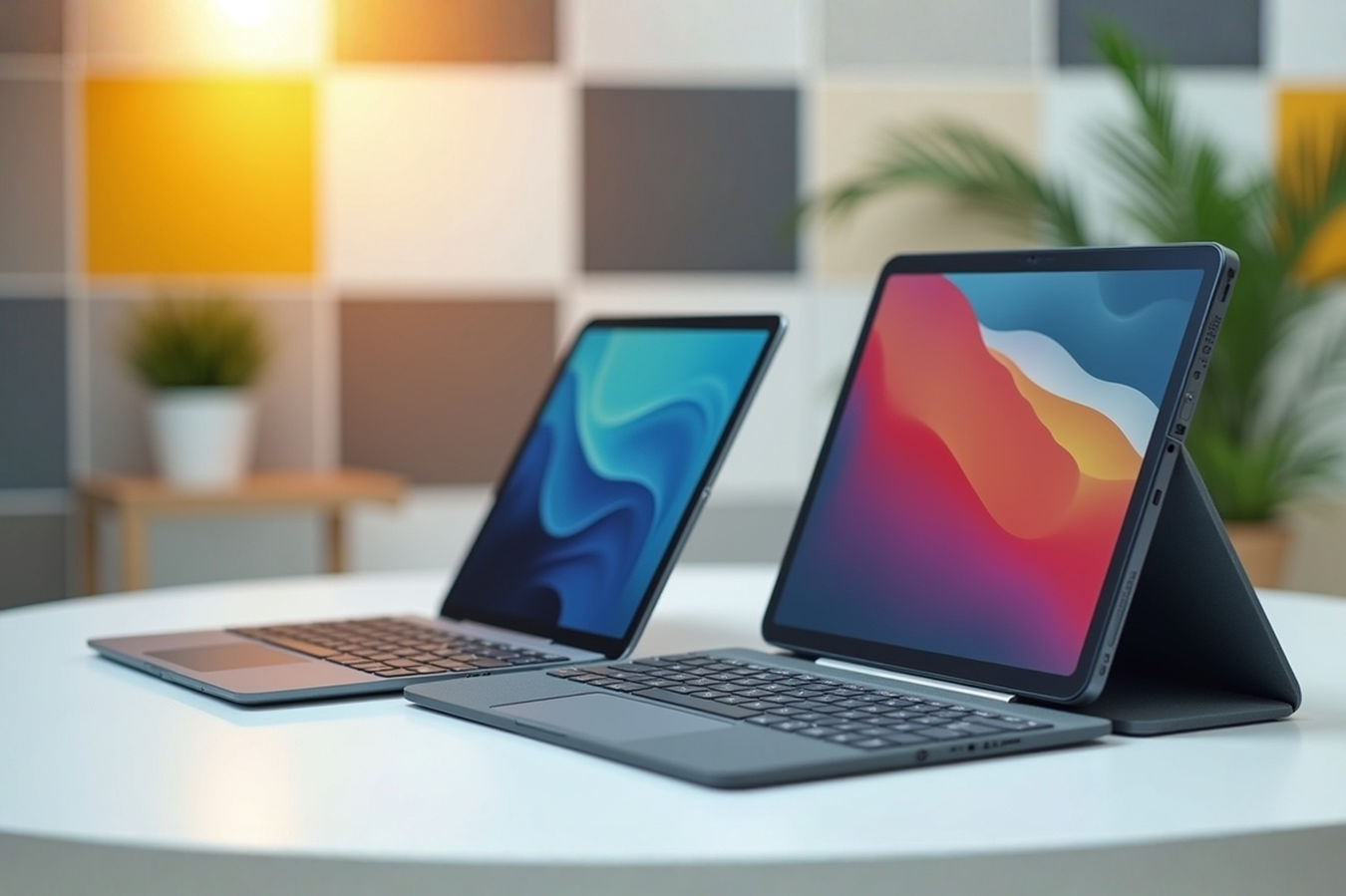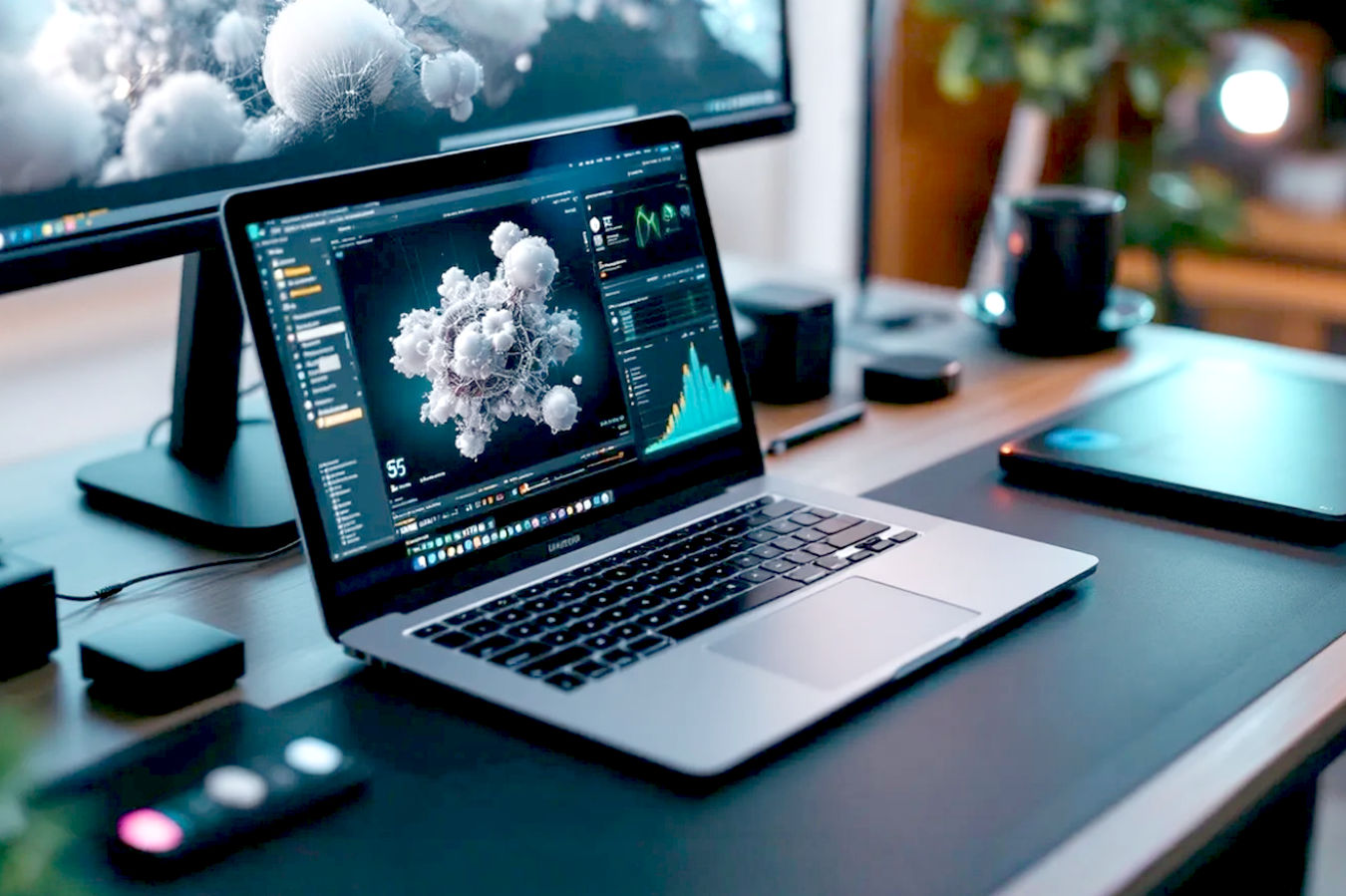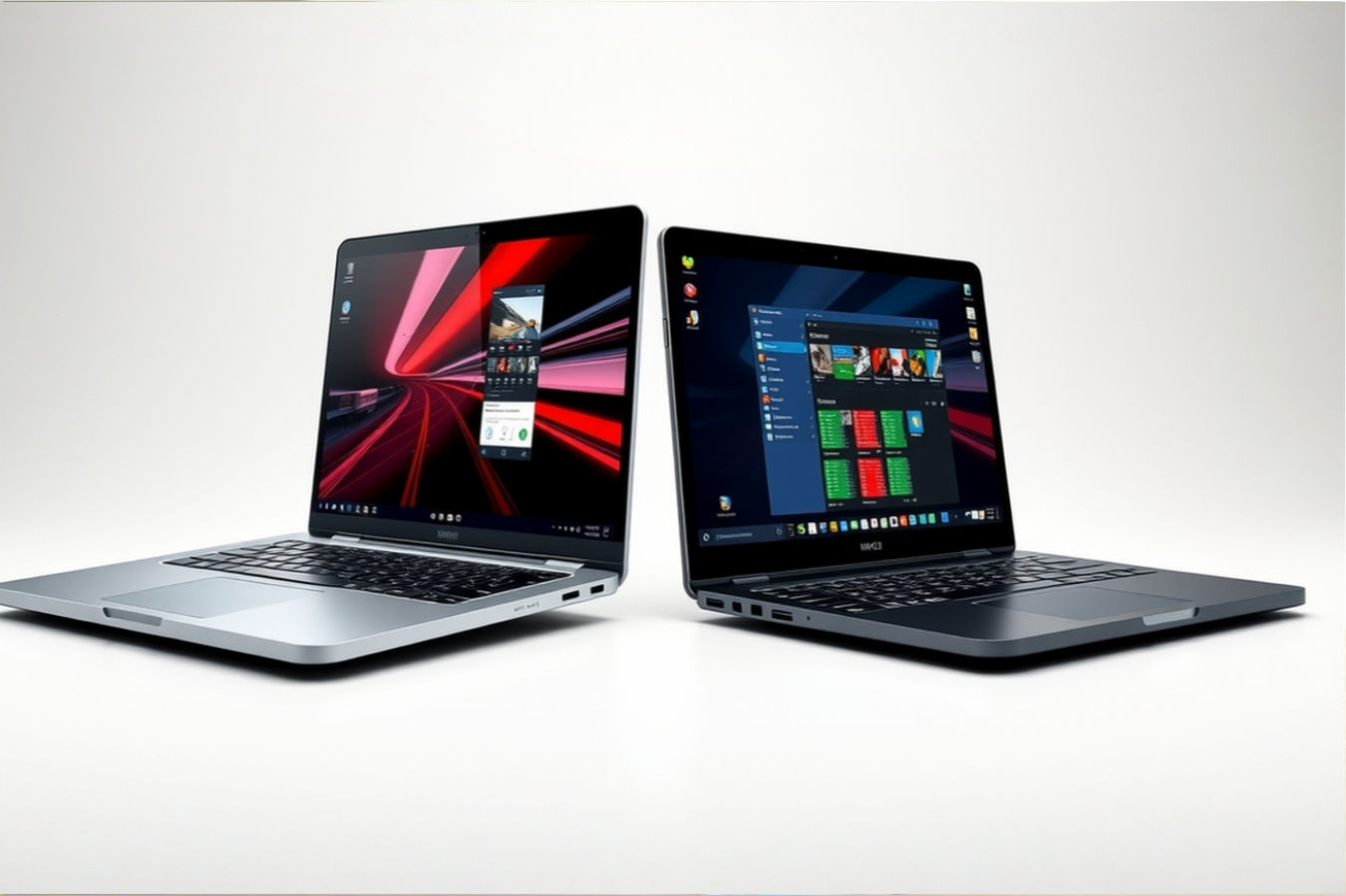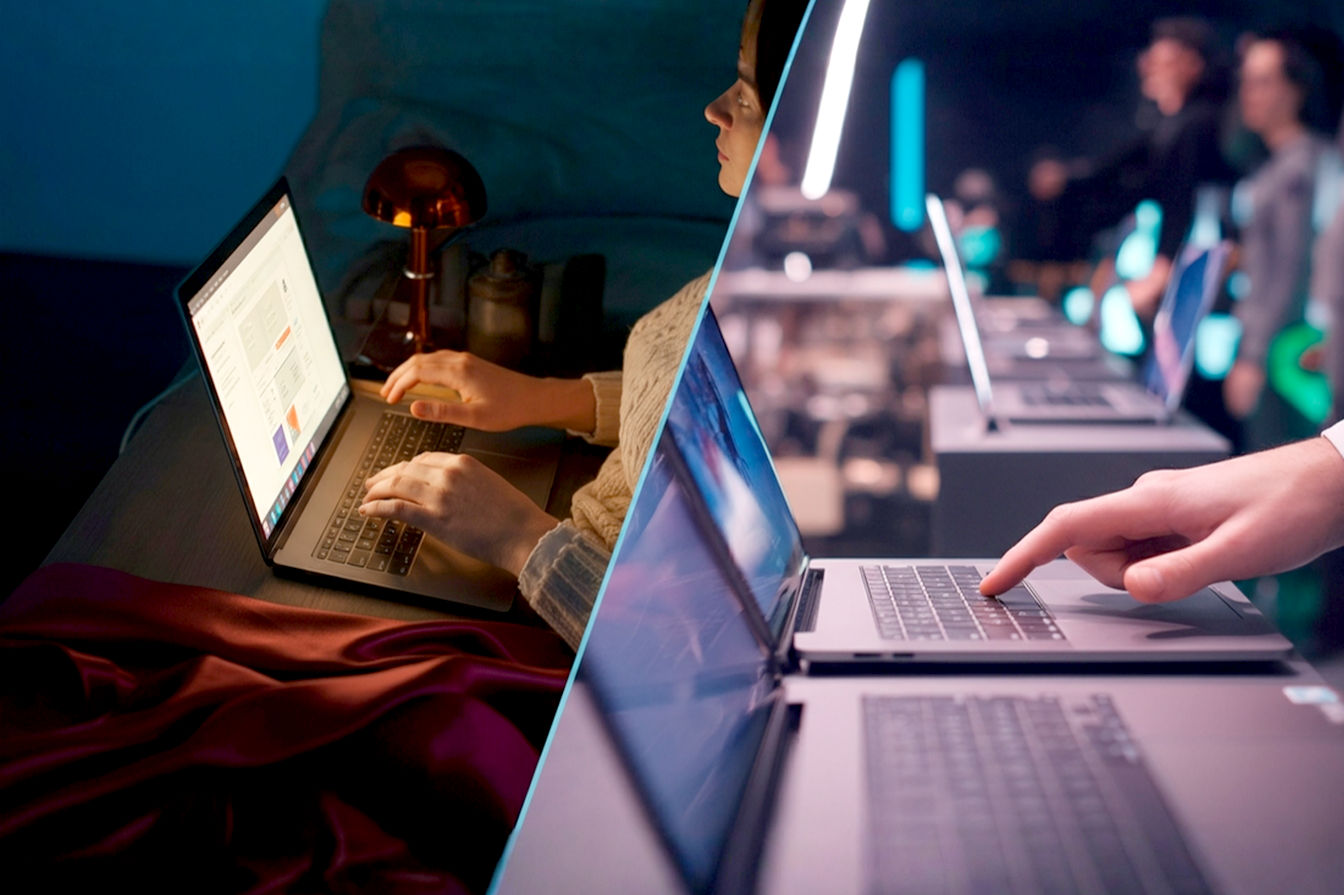This post may contain affiliate links. If you make a purchase through these links, we may earn a commission at no additional cost to you.
Introduction: The Rise of the Foldable PC
Imagine a computer screen you can fold in half like a book. That’s the core idea behind foldable laptops. For decades, laptops have followed a pretty standard design: a screen attached to a keyboard base with a hinge. While this design works well, it limits how portable or versatile a device can be. You either have a small screen for portability or a large screen that’s bulky to carry around.
Foldable laptops aim to break free from these limitations. They promise a single device that can transform. It could be a large display for watching movies or working, then fold down into a compact size that’s easy to slip into a bag. This isn’t just about a cool party trick; it’s about creating a new kind of personal computer that adapts to different needs throughout the day.
What are Foldable Laptops?
At their most basic, foldable laptops are computers featuring a display that can physically bend and fold. Unlike traditional laptops with rigid screens, these devices use flexible display technology, typically OLED. This allows the screen itself to fold, often around a complex hinge mechanism.
When unfolded, they can offer a large screen area, sometimes comparable to a standard laptop or even a desktop monitor. When folded, they become much smaller and more portable, often resembling a thick tablet or a small book. This ability to change form factors is their defining characteristic. They aren’t just laptops that fold; they are devices designed from the ground up to be flexible in both their physical form and how you use them.
Why Foldable? The Promise of Versatility
The main driver behind developing foldable laptops is versatility. Think about how you use different devices today. You might use a smartphone on the go, a tablet for reading or watching videos, and a laptop for work or creativity. Each device has its strengths, but switching between them can be a hassle.
A foldable laptop aims to combine the best aspects of these devices into one. Need a large screen for multitasking? Unfold it completely. Want to read an e-book comfortably? Fold it into a book-like shape. Need a traditional laptop experience? Fold it halfway and use a virtual or physical keyboard. This adaptability means you could potentially carry just one device instead of two or three. The promise is a seamless transition between different modes of use, making your computing experience more fluid and convenient. It’s about having the right tool for the job, all contained within a single, transforming device.
The Core Technology: How Foldable Screens Work
Making a screen that can bend and fold repeatedly without breaking is a significant technical challenge. It requires a combination of advanced materials science, display technology, and mechanical engineering. The magic happens primarily in two key areas: the flexible display panel itself and the sophisticated hinge mechanism that allows it to fold.
Flexible Display Panels: The Heart of the Innovation
Traditional displays, like those in your current laptop or phone, are built on rigid glass substrates. Glass is great for clarity and stability but snaps easily when bent. Flexible displays replace this rigid glass with materials that can withstand bending and flexing.
OLED Technology and Flexibility
The most common technology used in current foldable displays is Organic Light Emitting Diode, or OLED. Unlike Liquid Crystal Displays (LCDs) that require a separate backlight, each pixel in an OLED display generates its own light. This self-emissive property is crucial for flexibility. OLED panels are inherently thinner and simpler in structure than LCDs because they don’t need bulky backlighting layers. This reduced complexity makes them much more suitable for being built on flexible materials.
In a traditional OLED, layers of organic compounds are sandwiched between two electrodes, often on a glass base. When an electric current passes through, the organic compounds emit light. To make this flexible, the rigid glass is replaced with a bendable material.
Substrate Materials: Making Displays Bendable
Instead of glass, flexible OLED displays are typically built on very thin, flexible plastic or metal foil substrates. Polyimide (PI) is a popular choice for plastic substrates. It’s a durable, heat-resistant polymer that can be made incredibly thin while maintaining structural integrity. Some advanced displays might even use ultra-thin glass that is specially treated to be flexible, though this is less common in current foldable laptops compared to plastic substrates.
Building the intricate layers of an OLED display – the electrodes, the organic layers, and the pixel circuitry (Thin-Film Transistors or TFTs) – onto these flexible substrates requires extremely precise manufacturing processes. These layers must also be flexible themselves and able to withstand the stress of bending without cracking or delaminating.
Encapsulation Layers: Protecting the Flexible Electronics
OLED materials are sensitive to moisture and oxygen. In a rigid display, a glass layer provides protection. For flexible displays, robust, thin, and flexible encapsulation layers are needed. These layers, often made of multiple alternating films of inorganic (like silicon nitride or silicon dioxide) and organic materials, create a barrier to prevent environmental damage. This multi-layer thin-film encapsulation (TFE) is critical for the longevity and reliability of a flexible display. Without effective encapsulation, the display would quickly degrade and fail.
The Hinge Mechanism: Engineering the Fold
While the flexible screen gets a lot of attention, the hinge is equally, if not more, important. The hinge isn’t just about allowing the device to open and close; it’s a complex piece of engineering designed to manage the stress on the flexible display during folding and unfolding. A poorly designed hinge can lead to screen damage, a visible crease, or a poor user experience.
Types of Hinge Designs
Manufacturers have developed various hinge designs to achieve different folding outcomes and manage screen stress. Some common approaches include:
- Waterfall or Teardrop Hinge: This design creates a small loop or curve for the display when the device is closed. Instead of folding the screen into a tight angle (like 180 degrees), it allows the screen to wrap around a mechanism inside the hinge. This larger bending radius puts less stress on the display material, helping to reduce the visibility of a crease. Devices like the Lenovo ThinkPad X1 Fold Gen 2 use variations of this concept.
- Multi-Link Hinge: These hinges use multiple interconnected parts that move together to guide the display through the folding process. They are designed to ensure the screen is supported evenly across the fold line and to control the bending radius. The complexity lies in ensuring smooth operation and long-term durability.
- Gear-Based Hinges: Some designs incorporate intricate gear systems to provide precise control over the hinge movement and maintain the desired angle at various points of the fold. This can help create a stable feel when the device is partially folded.
Stress Distribution and Durability
A primary function of the hinge is to distribute the mechanical stress placed on the flexible display as it bends. When a material is bent, the outer surface is stretched, and the inner surface is compressed. For a flexible display with many thin layers, managing these opposing forces is vital. The hinge design influences the bending radius – the tighter the bend, the higher the stress. Waterfall hinges, by creating a larger radius, reduce this stress.
Engineers also use materials like carbon fiber or durable metal alloys in the hinge structure to ensure it can withstand tens or even hundreds of thousands of folding cycles. Manufacturers test hinges rigorously, often simulating years of typical use to ensure they meet durability standards.
Preventing the “Crease”
One of the most noticeable aspects of early foldable displays was a visible crease or wrinkle along the fold line. This crease is a result of the material being repeatedly bent. While flexible displays are designed to bend, the materials still experience some deformation. Hinge design plays a crucial role in minimizing this. By controlling the bending radius and ensuring the screen is properly supported, newer hinge designs significantly reduce the prominence of the crease. While a slight ripple might still be visible under certain lighting conditions on some models, it’s far less pronounced than in earlier generations. Ongoing research continues to focus on materials and hinge designs that can eliminate the crease entirely.
Key Components Enabling Foldability
Building a foldable laptop involves more than just a flexible screen and a complex hinge. Many other components that are traditionally rigid in standard laptops had to be rethought or adapted to work within a flexible, transforming design.
Flexible Batteries: Powering the Fold
Standard lithium-ion batteries are typically rigid rectangles. Fitting these into a device that folds presents challenges. While truly flexible batteries that can bend and fold alongside the screen are still largely in the research phase for high-capacity applications, foldable laptops often use innovative battery configurations. This might involve splitting the battery into multiple smaller, rigid sections placed in parts of the chassis that don’t bend, or using specially designed thin, slightly conformable battery packs. The placement and shape of these batteries are carefully planned to avoid interfering with the folding mechanism and to distribute weight evenly. Developing truly flexible, high-density batteries remains an area of active research that could further enhance the design possibilities for future foldable devices.
Flexible Circuitry and Connectors
Just like the display, the internal wiring and connections within a foldable laptop need to be able to bend and flex without breaking. Traditional rigid circuit boards and cables won’t work across the hinge. This requires the use of flexible printed circuit boards (FPCs) and durable, flexible cables. FPCs are made from flexible plastic substrates like polyimide, onto which conductive pathways are printed. These can bend and twist repeatedly. Connectors used across the fold line must also be designed to withstand constant movement and maintain reliable electrical contact. Materials science and advanced manufacturing techniques are critical for producing these reliable flexible electronic components.
Cooling Solutions for Compact, Foldable Designs
High-performance laptop components generate heat. Dissipating this heat is challenging in any compact device, but even more so in a foldable one where space is limited and the chassis shape changes. Traditional cooling systems with rigid heat pipes and fans need to be adapted. This might involve using thinner heat pipes, strategically placing vents, or even employing advanced cooling materials like vapor chambers that can conform slightly to the internal layout. Designing an effective cooling system that works reliably in both the unfolded and folded states, while remaining thin and lightweight, is a significant engineering hurdle. Manufacturers must balance performance needs with thermal limitations imposed by the foldable form factor.
Protective Layers: Ensuring Screen Longevity
Beyond the internal encapsulation, the outermost layer of a foldable screen is crucial for protecting it from scratches and damage during everyday use. Early foldable phones used a flexible plastic protective layer, which was softer and more susceptible to scratches than the glass used on traditional displays. Newer foldable laptops and phones are starting to incorporate ultra-thin, flexible glass (UTG) or advanced polymer composites that offer better durability while still allowing the screen to bend. This protective layer is a critical interface between the user and the delicate flexible display underneath. Its resistance to scratches and impacts directly impacts the perceived durability and longevity of the device. Research continues into finding materials that offer glass-like hardness with plastic-like flexibility.
Current State of Foldable Laptops
Foldable laptops are no longer just concepts shown at tech demos; they are real products you can buy, albeit at a premium price. Several major manufacturers have entered the market, each with their own take on the form factor and features.
Available Models and Manufacturers
The foldable laptop market is still relatively nascent, but a few key players have launched commercially available devices.
- Lenovo ThinkPad X1 Fold: Often considered one of the pioneers in this space, Lenovo has released multiple generations of the ThinkPad X1 Fold. These devices typically feature a single large foldable display that can be used in various orientations, often paired with a detachable keyboard. The ThinkPad line emphasizes a premium, business-oriented design and features.
- Asus Zenbook Fold: Asus has also introduced foldable laptops under its Zenbook line, such as the Zenbook 17 Fold OLED. These devices also feature a large foldable screen and offer multiple modes of use, often highlighting the vibrant OLED display quality.
- HP Spectre Foldable PC: HP has entered the market with devices like the HP Spectre Foldable PC, focusing on a premium design and a combination of foldable display and accompanying accessories like a magnetic keyboard and stylus.
These early models represent the first generation of foldable PCs, showcasing the potential of the technology while also highlighting areas for improvement.
Form Factors and Use Cases
One of the most compelling aspects of foldable laptops is their ability to transform into different form factors, each suited to different tasks.
Laptop Mode
This is perhaps the most familiar mode. The device is folded partially, with one half of the screen acting as the main display and the other half (or a connected accessory) serving as a keyboard and trackpad area. This replicates the traditional laptop experience, suitable for typing, productivity, and general computing tasks. Some foldable laptops use a virtual keyboard on the lower screen half, while others come with a physical keyboard that can be placed on top of the lower screen section, offering a more tactile typing experience.
Tablet Mode
When fully unfolded, the device becomes a large, flat tablet. This mode is ideal for touch-based interactions, drawing with a stylus, browsing the web, reading, or watching videos on a large display. The size of the unfolded screen can be significantly larger than a typical tablet, offering a more immersive experience.
Book Mode
Folding the device partially, like closing a book, allows for a reading experience similar to holding a large e-reader or a physical book. This mode is comfortable for reading documents, e-books, or long articles. The hinge allows the device to stay open at a comfortable angle.
Desktop Mode
With the help of a stand (often built-in or included as an accessory) and potentially an external keyboard and mouse, a foldable laptop in its fully unfolded state can function as a large-screen desktop monitor. This allows for a more traditional workstation setup, ideal for multitasking, creative work, or connecting to external peripherals.
Performance and Specifications
The performance of current foldable laptops varies depending on the specific model and manufacturer. Early generations often featured components optimized for efficiency rather than raw power, similar to ultraportable laptops or high-end tablets. This was partly due to thermal limitations within the compact, foldable design.
However, newer models are incorporating more powerful processors, including Intel Core i5 or i7 processors and sufficient RAM (e.g., 8GB or 16GB) and fast SSD storage. While they may not match the performance of high-end gaming laptops or mobile workstations, they are capable of handling typical productivity tasks, web browsing, media consumption, and even some more demanding applications. The focus is on providing a capable computing experience within the unique foldable form factor.
Pricing and Market Position
Foldable laptops currently occupy the premium segment of the PC market. Their innovative technology, complex engineering, and lower production volumes contribute to high price tags, often starting well over $2000 and sometimes exceeding $4000. This positions them as luxury items or devices for early adopters and professionals who can justify the cost for the unique form factor and versatility. As the technology matures and production scales up, prices are expected to decrease, making foldable laptops more accessible to a broader audience in the future.
Technical Challenges and Limitations
Despite the impressive engineering that has brought foldable laptops to market, the technology still faces significant technical challenges and limitations that manufacturers are working to overcome.
Screen Durability and Longevity
This is arguably the most significant concern for potential buyers. Flexible screens, while designed to bend, are inherently different from rigid glass displays.
Scratch Resistance
The outermost protective layer, whether plastic or ultra-thin glass, is still generally less scratch-resistant than the toughened glass (like Gorilla Glass) used on traditional laptops and smartphones. Users need to be more careful to avoid scratches from fingernails, keys, or other objects.
Crease Visibility
As mentioned earlier, a visible crease along the fold line has been a characteristic of foldable displays. While newer hinge designs and materials have reduced its prominence, it can still be noticeable, especially under certain lighting conditions or viewing angles. For some users, this visual imperfection can be distracting.
Long-term Folding Stress
Repeatedly folding and unfolding the display puts mechanical stress on all the layers within the panel, including the flexible substrate, the OLED materials, the electrodes, and the encapsulation layers. While manufacturers test for many thousands of folds, the long-term effects of this constant stress over several years of use are still being evaluated. Ensuring the display maintains its performance and integrity after tens or hundreds of thousands of folds is crucial for widespread adoption. Research into more resilient flexible materials and display structures is ongoing.
Hinge Complexity and Reliability
The intricate multi-component hinges are critical for the device’s functionality, but their complexity also presents potential points of failure. Dust and debris entering the hinge mechanism could cause issues. The long-term reliability of the moving parts under constant stress is a key concern. Manufacturers use durable materials and rigorous testing, but the hinge remains a complex subsystem that must perform flawlessly over the device’s lifespan.
Software Optimization for Folding Displays
Operating systems and applications are primarily designed for traditional, rigid, rectangular displays. Adapting software to seamlessly transition between different form factors and screen orientations on a foldable device is challenging. Issues can arise with app scaling, window management, and ensuring a smooth user interface when the screen is folded or unfolded. While operating systems like Windows are being updated to better support these dynamic displays, developers also need to optimize their applications to take full advantage of the unique capabilities of foldable screens. This includes how content reflows, how virtual keyboards appear, and how multitasking works in different modes.
Cost of Manufacturing
Producing flexible OLED displays and complex, durable hinges is significantly more expensive than manufacturing traditional rigid displays and standard laptop hinges. The specialized materials, precise manufacturing processes, and lower production volumes contribute to the high cost. As production scales up and yields improve, the cost is expected to decrease, but it remains a major barrier to making foldable laptops mainstream.
Battery Life in Flexible Designs
Integrating sufficient battery capacity into a thin, foldable design is difficult. The need to split batteries or use specially shaped packs can sometimes limit the total battery capacity compared to a similarly sized traditional laptop. Furthermore, powering a large, high-resolution OLED display can consume a significant amount of power. While power efficiency of components is improving, achieving all-day battery life in all usage modes remains a challenge for some foldable models.
Thermal Management Issues
As mentioned in the components section, keeping a powerful processor cool within a compact, transforming chassis is complex. The limited space and changing form factor can restrict airflow and heat dissipation. This can sometimes lead to thermal throttling, where the processor reduces its speed to prevent overheating, potentially impacting performance during demanding tasks. Engineers are developing more efficient cooling solutions, but it remains a design constraint.
The User Experience: Pros and Cons
Putting aside the technical details for a moment, how do these challenges and innovations translate into the actual experience of using a foldable laptop? There are clear advantages that highlight their potential, but also disadvantages that reflect the current state of the technology.
Advantages of Foldable Laptops
Enhanced Portability and Compactness
This is perhaps the most obvious benefit. A device that offers a large screen when open can fold down into a much smaller, more manageable size for transport. This makes it easier to carry in smaller bags and more convenient for computing on the go. For users who need a large screen but value portability, this is a significant advantage.
Increased Screen Real Estate in a Smaller Footprint
When unfolded, a foldable laptop can provide a screen size typically found in larger, heavier traditional laptops. For example, a device that folds down to the size of a 13-inch laptop might unfold to offer a 17-inch display. This extra screen space is invaluable for multitasking, viewing detailed content, or simply having a more immersive viewing experience, all without the bulk of a traditional large-screen laptop.
Versatile Form Factors
The ability to switch between laptop, tablet, book, and desktop modes is a major draw. This adaptability means the device can be used comfortably in a wider range of scenarios, from working at a desk to reading on a couch or giving a presentation. It allows the user to choose the best mode for the task at hand.
Disadvantages of Foldable Laptops
High Cost
As discussed, the price is a significant barrier for most consumers. Foldable laptops are currently a premium product, limiting their accessibility.
Potential Durability Concerns
Despite improvements, concerns about the long-term durability of the flexible screen and hinge persist. While manufacturers offer warranties and support, the idea that the screen could be more susceptible to scratches or damage than a traditional glass display makes some potential buyers hesitant.
Weight and Thickness (Compared to traditional laptops/tablets)
While they become more compact when folded, foldable laptops are often thicker and sometimes heavier than traditional laptops or tablets of a similar screen size (when unfolded). The complex hinge and internal components add bulk and weight. So, while they are more portable in terms of footprint, they aren’t necessarily the lightest or thinnest devices available.
Software Compatibility and Optimization Issues
Although improving, the software experience can sometimes feel less polished than on traditional devices. Some applications may not scale perfectly, and the transition between modes isn’t always seamless. Users might encounter occasional glitches or a less optimized interface compared to devices designed for a single form factor.
Learning Curve for New Form Factors
Using a device that can transform requires some adjustment. Users need to learn how to best utilize the different modes and how the software behaves in each configuration. While intuitive for many, it’s a departure from the familiar experience of a standard laptop or tablet.
The Future of Foldable Technology
Foldable laptops are still in their early stages. Like any new technology, they will evolve significantly over time. The challenges faced today are driving innovation that will shape the future of portable computing.
Evolution of Display Technology
Research into flexible displays is ongoing. We can expect improvements in OLED technology, leading to brighter, more power-efficient, and even more durable flexible panels. New display technologies like MicroLED, which uses microscopic LEDs to create pixels, also hold promise for future flexible and foldable applications, potentially offering higher brightness and longer lifespan than OLEDs. These advancements will likely lead to screens with less visible creases, better scratch resistance, and improved overall performance.
Advancements in Hinge Design
Engineers will continue to refine hinge mechanisms to be more durable, thinner, lighter, and even less visible. Future hinges might completely eliminate the screen crease, offer a wider range of stable angles, or be integrated more seamlessly into the device’s design. Improved materials and manufacturing techniques will play a key role in these advancements.
Integration into More Devices
The technology developed for foldable laptops is also applicable to other devices. We are already seeing foldable smartphones and concept foldable tablets and monitors. In the future, we might see a wider range of foldable devices, from truly pocketable computers to large, foldable displays that can be rolled up for transport.
Potential for New Computing Paradigms
Foldable technology could enable entirely new ways of interacting with computers. Imagine a device that unfolds into a massive display for immersive gaming or creative work, then folds into a small, portable device for on-the-go tasks. Foldable screens could also lead to new interface designs, perhaps with interactive areas on the folded edges or dynamic screen layouts that change based on how the device is held.
Decreasing Costs and Increased Accessibility
As production scales up, manufacturing processes become more efficient, and competition increases, the cost of foldable display technology and hinge mechanisms will decrease. This will make foldable laptops and other foldable devices more affordable and accessible to a wider range of consumers, moving them from a niche, premium product to a more mainstream option.
Comparison: Foldable Laptops vs. Traditional Laptops vs. Tablets
To truly understand the place of foldable laptops, it’s helpful to compare them to the established categories of portable computing devices.
Portability and Form Factor Comparison
- Traditional Laptops: Offer a fixed clamshell design. Portability depends on screen size and weight. Generally less portable than tablets but offer a built-in keyboard.
- Tablets: Highly portable due to their thin and light slate design. Lack a built-in physical keyboard, relying on touch or external accessories. Limited in screen size compared to unfolded foldable laptops.
- Foldable Laptops: Offer the most versatile form factor. Can be compact for portability (when folded) and provide a large screen (when unfolded). Bridge the gap between tablets and laptops in terms of adaptability. However, often thicker and sometimes heavier than traditional devices of a similar screen size.
Performance and Functionality Comparison
- Traditional Laptops: Range from basic models to high-performance workstations. Offer a full desktop operating system and are generally best for demanding productivity, creative work, and gaming.
- Tablets: Performance varies widely, from basic models for media consumption to powerful devices capable of handling many productivity tasks. Primarily designed for touch interaction and mobile operating systems, though some run desktop OS variants.
- Foldable Laptops: Performance is improving but generally sits between high-end tablets and mid-range to high-end traditional laptops. Capable of running full desktop operating systems and handling most productivity tasks. Their unique functionality comes from the transforming display.
Cost and Value Comparison
- Traditional Laptops: Available across a wide price spectrum, from budget-friendly to very expensive premium models. Offer a wide range of performance options for the price.
- Tablets: Also available at various price points, generally less expensive than traditional laptops with similar performance.
- Foldable Laptops: Currently the most expensive option. The high cost reflects the cutting-edge technology and complex manufacturing. Value proposition is based on the unique versatility and large screen in a portable package, which may not be worth the premium for all users.
Target Audience and Use Case Comparison
- Traditional Laptops: Ideal for users who need consistent performance, a physical keyboard for extensive typing, and run demanding desktop applications. Suitable for students, professionals, and power users.
- Tablets: Best for users prioritizing portability, touch interaction, media consumption, reading, and light productivity. Suitable for casual users, travelers, and those who prefer a touch-first interface.
- Foldable Laptops: Target early adopters, professionals who need maximum versatility and portability, and users who can benefit from the large screen in a compact form factor. Suitable for those who want a single device to handle tasks typically spread across a laptop and a tablet, and who are willing to pay a premium for the latest technology.
Conclusion: Are Foldable Laptops the Future?
Foldable laptop technology is a significant leap forward in portable computing. It represents a genuine attempt to rethink the traditional laptop form factor and create a device that is more adaptable to the varied ways we use computers today. The ability to transform from a compact, portable device into a large-screen display offers compelling advantages in terms of versatility and screen real estate.
Summarizing the Technology and Current State
We’ve seen how flexible OLED displays, built on bendable substrates with robust encapsulation, are the foundation. We’ve also explored the critical role of sophisticated hinges in managing screen stress and enabling smooth folding. Current models from companies like Lenovo, Asus, and HP showcase the potential, offering multiple form factors and capable performance, albeit at a high price point.
Weighing the Potential Against the Challenges
The potential for a single device that seamlessly transitions between laptop, tablet, and other modes is exciting. It could simplify our digital lives and enable new ways of working and playing. However, significant challenges remain. Concerns about screen durability, the visibility of the crease, the complexity and long-term reliability of the hinge, and the high cost are real barriers to widespread adoption. Software optimization is also an ongoing process.
The Path Forward for Foldable Computing
Despite the current limitations, the trajectory of foldable technology is clear. Ongoing research and development in materials science, display technology, and mechanical engineering will lead to more durable screens, less visible creases, more robust hinges, and eventually, lower manufacturing costs. As the technology matures and becomes more affordable, and as software ecosystems better support dynamic displays, foldable laptops are likely to become a more viable and attractive option for a broader audience.
Are foldable laptops the future of portable computing? It’s perhaps too early to say they will completely replace traditional laptops or tablets. However, they certainly represent a significant and promising part of the future. They offer a glimpse into a world where our devices are more fluid, adaptable, and capable of meeting our diverse computing needs within a single, elegant package. The journey has just begun, and it will be fascinating to see how this technology evolves and shapes the way we interact with computers in the years to come.






